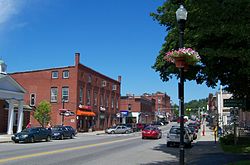2010 census
As of the census [14] of 2010, there were 7,760 people, 3,072 households, and 1,597 families residing in the town. The population density was 139.4 inhabitants per square mile (53.8/km2). There were 3,441 housing units at an average density of 61.8 per square mile (23.9/km2). The racial makeup of the town was 96.9% White, 0.3% African American, 0.4% Native American, 0.3% Asian, 0.1% Pacific Islander, 0.3% from other races, and 1.7% from two or more races. Hispanic or Latino of any race were 1.3% of the population.
There were 3,072 households, of which 23.1% had children under the age of 18 living with them, 38.2% were married couples living together, 9.9% had a female householder with no husband present, 3.9% had a male householder with no wife present, and 48.0% were non-families. 34.1% of all households were made up of individuals, and 13% had someone living alone who was 65 years of age or older. The average household size was 2.17 and the average family size was 2.75.
The median age in the town was 32.1 years. 16% of residents were under the age of 18; 27.2% were between the ages of 18 and 24; 18.3% were from 25 to 44; 23.3% were from 45 to 64; and 15.5% were 65 years of age or older. The gender makeup of the town was 45.3% male and 54.7% female.
2000 census
As of the census of 2000, there were 7,410 people, 2,813 households, and 1,533 families residing in the town. The population density was 132.8 inhabitants per square mile (51.3/km2). There were 3,048 housing units at an average density of 54.6 persons/sq mi (21.1 persons/km2). The racial makeup of the town was 97.48% White, 0.20% African American, 0.30% Native American, 0.65% Asian, 0.03% Pacific Islander, 0.40% from other races, and 0.94% from two or more races. 0.82% of the population were Hispanic or Latino of any race.
There were 2,813 households, out of which 24.8% had children under the age of 18 living with them, 42.5% were married couples living together, 9.1% have a woman whose husband does not live with her, and 45.5% were non-families. 31.7% of all households were made up of individuals, and 11.8% had someone living alone who was 65 years of age or older. The average household size was 2.25 and the average family size was 2.87.
In the town, the population was spread out, with 18.4% under the age of 18, 25.0% from 18 to 24, 21.5% from 25 to 44, 19.3% from 45 to 64, and 15.9% who were 65 years of age or older. The median age was 32 years. For every 100 females, there were 81.0 males. For every 100 females age 18 and over, there were 75.1 males.
The median income for a household in the town was $26,814, and the median income for a family was $33,656. Males had a median income of $27,569 versus $21,101 for females. The per capita income for the town was $13,982. About 18.0% of families and 22.6% of the population were below the poverty line, including 30.6% of those under the age of 18 and 5.4% ages 65 or older.










